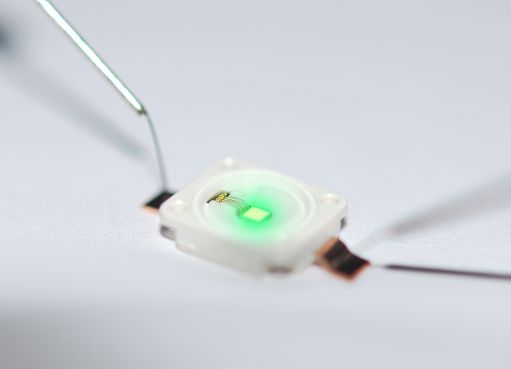Longer battery life for fitness trackers: Osram increases the efficiency of green LEDs by 40 percent
Increased performance thanks to the world's lowest values for forward voltages
The significant drop in light output (green gap phenomenon) exhibited by green LEDs has often been the cause of efficiency problems and high costs in customer applications. For its indium gallium nitride (InGaN)-based green LEDs, Osram Opto Semiconductors has now succeeded in reducing the typical forward voltages by around 600 mV drastically. With a simultaneous increase in optical output power, customers instantly benefit from improvements in efficiency of up to 40 percent compared to predecessor products across the entire UX:3 portfolio from Osram.
Developers at Osram Opto Semiconductors have managed to reduce the typical forward voltages of green direct emitting InGaN LEDs by 600 mV to 2.6 V at power densities of 45 A/cm2. The benefits are considerable, particularly for applications in which red, blue and green LEDs are used in combination. Because all three colors now have a voltage of less than 3 V the drivers, which were previously designed for higher maximum voltages, can now be dimensioned smaller. This in turn reduces both dissipative power loss and costs. The crucial factors in increasing efficiency were improved charge carrier transport and optimized material quality in the epitaxial layers.
At 350 mA, 1 mm2 UX:3 chips achieve efficiencies of 175 lm/W and higher at wavelengths around 530 nm with the new technology. Absolute light output in excess of 300 lm at a pumping current of 1 A opens up new applications for customers.
“Until recently, these efficiency values seemed unattainable for green direct emitting InGaN LEDs. We are now moving into areas that up to now have been achievable only with phosphor conversion emitters but with significantly reduced spectral quality. Thanks to the success of our development team we have been able to drastically reduce the green gap phenomenon for our customers,” said project manager Adam Bauer from Osram Opto Semiconductors.
The team is currently working on further improvements that offer potential which has become evident as a result of the recent findings.

ABOUT OSRAM
OSRAM, based in Munich, is a leading global high-tech company with a history dating back more than 110 years. Primarily focused on semiconductor-based technologies, our products are used in highly diverse applications ranging from virtual reality to autonomous driving and from smart phones to smart and connected lighting solutions in buildings and cities. OSRAM uses the endless possibilities of light to improve the quality of life for individuals and communities. OSRAM’s innovations enable people all over the world not only to see better, but also to communicate, travel, work and live better. OSRAM has approximately 26,400 employees worldwide as of end of fiscal 2017 (September 30) and generated revenue of more than €4.1 billion. The company is listed on the stock exchanges in Frankfurt and Munich (ISIN: DE000LED4000; WKN: LED400; trading symbol: OSR). Additional information can be found at www.osram.com.